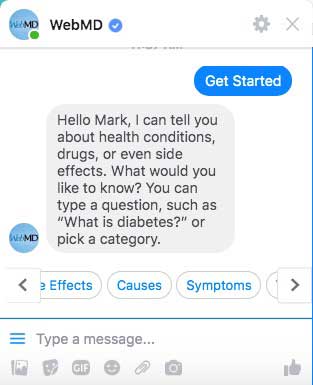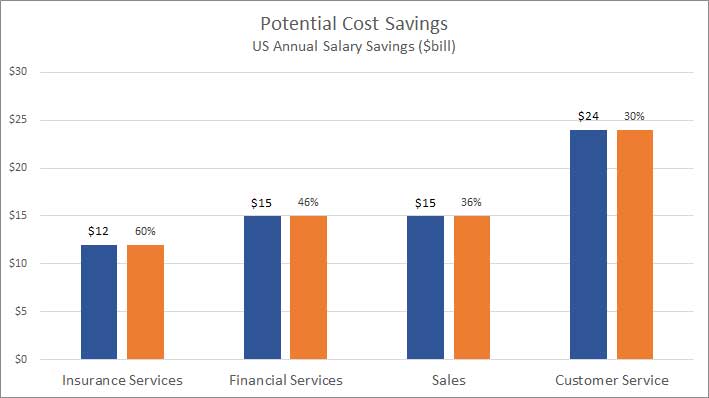Healthcare and pharma companies have ramped up their AI spend in the last few years. Pharma chatbots are an area of particular interest because the technology is available and has produced substantial ROI for other industries. Let’s look at a few examples of chatbots that could improve ROI and patient outcomes.
Chatbots That Are (Theoretically) Possible Now
SymptomsBot—A Patient-Facing Pharma Chatbot That Screens Users Based on Their Symptoms
Search engines are chock-full of searches for the cause of symptoms. However, pharma companies are having a hard time converting these searches to leads on their own websites. Resources like WebMD are much more likely to appear for symptoms searches. Those sites have content on every disease that might be causing a symptom, and enjoy much better search engine visibility. Once they know their condition, consumers trust patient influencers for treatment-related questions.
Pharmaceutical companies might be able to use chatbots to convert symptom searches into treatment conversations. WebMD’s Facebook Profile features a chatbot that allows one to learn about their symptoms. However, the bot can only direct users to general information pages that contain a list of diseases that might be causing the symptom.

After the user types ‘Get started’ in the dialogue box, the chatbot provides a list of queries for which responses are available.

The chatbot’s response to the user entering ‘Fatigue’ is general, but does call out possible illnesses that can cause excess fatigue. Eventually, a link is provided to a more in-depth page with resources.
A pharmaceutical brand’s chatbot would have the advantage of being able to start with a more specific end in mind. The chatbot can direct users to a telemedicine service once it appears that a user is a candidate for treatment. A pharmaceutical Google Ads campaign can get the chatbot to the top of the search results page for symptoms searchers.
Chatbots can produce 10x the engagement rate as ones without them. The upside is significant.
RepBot—A Physician-Facing Pharma Chatbot That Schedules Pharma Rep Appointments
A revolutionary new drug launches and a company’s sales reps are overwhelmed with appointment requests. Rather than placing the burden on its reps to schedule their appointments, the pharma company could use a bot. The chatbot could ask HCPs for their availability and then find the nearest rep with an open time slot to schedule a visit. The bot could then send a push notification to the rep and the physician about the appointment.
Admittedly, this chatbot would have a couple of obstacles needing solutions. First, the chatbot would need to be cleverly promoted. Having it live on the brand’s HCP site would be a good start, but probably would not be enough. A combination of Epocrates search sponsorship, takeovers physician specialty websites, email promotion, and Google Ads PPC promotion could be an effective way to maintain a stream of potential leads.
The second possible issue with this HCP-facing chatbot is that it would require creative sales representative organization. Automatically selecting a representative in the traditional territory and compensation structure model could generate frustration. Things might not roll out smoothly at first. For a launch, this could be disastrous. Some reps might get far too many leads and some might end up being lead-starved.
Solving these problems, however, could create an efficient combination of personal and non-personal promotion. A lead generation plan in which reps go only where they’re needed might produce cost-savings of 36% in sales representative salaries. Again, the technology exists, but it’s a risky venture for whoever decides to be the pioneer.
BenefitsBot—A Benefits Investigation Platform Chatbot That Serves Patients, Investigators, and Payers
Electronic benefits verifications (eBV) providers like Lash Group have started to really streamline the benefits verification process with artificial intelligence. These services use machine learning and AI to detect real time changes in formularies and individual plans. They cut back on the administrative burden of looking up such changes. A chatbot component of these services could benefit all parties.
Benefits investigators could submit queries based on a patient’s name and the therapy that is requested alone. The chatbot could take indexed information about the patient and either return an immediate report on their eligibility, automatically generate and submit a prior authorization request to the payer, or recommend step therapy if approval is not likely.
Patients would benefit too. A patient-facing app that is licensed to participating medical offices could allow one to quickly check on the status of a benefits investigation.
Payer cooperation with the data involved in the process could cut back on a lot of agent work. After all, one of the primary advantages of chatbots is that they automate simple tasks like looking up policy numbers and deductibles.
As you can see in the screenshot below, payers and medical offices could obtain save 30%-60% on labor savings from such a program. It’s not too hard to imagine a scenario in which they would do all that they can to cooperate with such a resource if those kinds of savings are on the table.

Credit to Chatbots Magazine: https://bit.ly/2ycDHgp
eServiceBot—A Hub-Based Pharma Chatbot To Meet Increased Demand For Patient Support Services
Patients are becoming increasingly involved in the healthcare process. They’re equipped with more information and are more engaged in their healthcare decisions than ever. As HCPs become more and more crunched for time, these so-called ‘E-Patients’ will need to have brand resources at their fingertips.
Pharma chatbots that provide resources on-demand could prevent the need to hire a large number of customer service reps. Machine learning and AI could help patients enroll in bridge programs, access adherence support tools, and get the most out of their treatment.
As we discussed above, chatbots excel at streamlining customer service responsibilities. Increasingly engaged patients will need pharma to fill in the gaps of understanding in the treatment process.
A Healthcare Chatbot That Could Exist in the Future
LifeBot—A Voice-Assisted Healthcare Chatbot That Monitors Vitals and Recommends Emergency Treatment
Investment in wearable technology for healthcare purposes has been underway for years. Livongo is hoping to enable Fitbit and other wearables to monitor a patient’s heart and other vitals. A chatbot that enables users to ask if their vitals are normal or why they are experiencing certain symptoms could enable them to seek treatment faster.
A healthcare chatbot that can communicate with a patient about their vitals could be decades off. The complexity of a bot that understands which vitals are normal and which are not and then decide if immediate attention is needed would be enormously complicated. But the benefits would be huge.
A less integrated but more immediate application is already being developed by State Farm. The company is developing a voice-assist ‘skill’ (app) for Alexa that allows seniors to connect with their families through their Amazon Echo Show devices. It could only be a matter of time before digital assistants start taking biological input from users as well.
What’s Your Idea for a Healthcare or Pharma Chatbot?
Got an idea of a healthcare or pharma chatbot? Let us know in the comments below!
